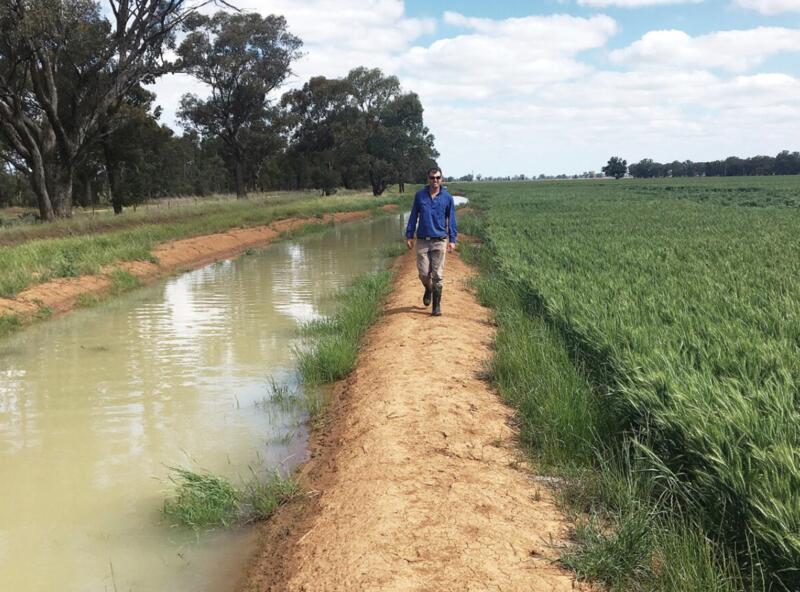IN the past decade or so we’ve seen irrigation technology and efficiency progress enormously. Yet irrigation farmers are still misrepresented by journalists and attacked by environmentalists, many of whom are just badly informed.
I live on an irrigation property at Berrigan in the Riverina where I’ve been growing wheat, barley, canola, lupin, corn, rice and Merino sheep for five years. My parents were farmers, but I left to do a marketing degree at Monash University in Melbourne before heading off to the United States for a year to do contract harvesting.
In 2004 I came back to Australia and took a job with NAB Agribusiness. It allowed me to travel and see different farming areas across the country. After nine years in banking, I finally answered the call to return to farming.
Irrigation farming is like having rainfall on tap. You can take a crop that’s struggling or on the verge of dying, fertilise it and water it a couple of times and you end up with a bumper crop. The vast majority of irrigation water use is controlled by regulations and licences. Farmers need an authorised allocation that allows us to take specified amounts from rivers, bores or a supply system.
My water comes from the Murray River out of the Hume and Dartmouth dams, which also supply about 300 other local farms. But it all depends on whether or not we get an allocation. Last year we got nothing, despite weeks of pleading with water authorities to increase our allocation from 0%.
 Andrew on his Riverina property in 2017 with his wheat crop after two waterings at 1.5 megalitres per hectare – and some spring rain.
Andrew on his Riverina property in 2017 with his wheat crop after two waterings at 1.5 megalitres per hectare – and some spring rain.
Water has always been a huge issue and not just because of the lack of rain. Now the problem is more about the misuse of water by bureaucrats and the fact governments are not managing the river properly. Megalitres of water from the Murray River dams is being wasted rather than allocated to properties, and the worst part is the whole system has to wear the losses. Farmers here have been battling to get the rules amended so the horrendous losses are no longer taken off our accounts.
Whenever there’s a big environmental issue, such as the
Menindee fish kills, irrigation farmers are the first to be blamed for taking all the water. People don’t see that the rivers aren’t running efficiently. They just believe what the mainstream media tells them, which is rarely the full story. It’s not surprising some city folk see farmers as environmental vandals, even though nothing could be further from the truth. Farmers don’t waste a drop of water and, in most places, irrigation benefits the environmental footprint.
RELATED ARTICLES:
To change that misunderstanding, we need to improve how we market farming to the media and get a better message out. I see two marketing principles that could be worked on for better outcomes: product and place.
RELATED: Hunter Valley farmer takes on mining company – and wins
Our product includes everything farmers are producing for the community, and place is where we market that product. Australia has excellent food safety standards and environmental watchdogs that don’t exist in many other countries, which means our produce is often safer, tastier and more environmentally friendly.
To change that misunderstanding, we need to improve how we market farming to the media and get a better message out. I see two marketing principles that could be worked on for better outcomes: product and place.
R
To change that misunderstanding, we need to improve how we market farming to the media and get a better message out. I see two marketing principles that could be worked on for better outcomes: product and place.
R
To change that misunderstanding, we need to improve how we market farming to the media and get a better message out. I see two marketing principles that could be worked on for better outcomes: product and place.
To change that misunderstanding, we need to improve how we market farming to the media and get a better message out. I see two marketing principles that could be worked on for better outcomes: product and place.
R
Farming has become highly specialised and multi-faceted. It’s evident rural communities know what farmers do and how environmentally conscious we have to be, but people in the cities don’t fully understand where their food comes from.
The growing popularity of neighbourhood farmers’ markets gives a face to farmers, but we need to spend more time and effort educating and promoting our business ideas to urbanites in ways they will understand and appreciate. Marketing and advertising may be seen to be unnecessary, but it really is essential we get the message right.
**Andrew Hawkins is a NSW Farmers committee member, but these are his personal views. If you would like to be ‘On my soapbox’ in a future issue of The Farmer, email: [email protected] or write to: The Farmer, Suite 27/26-32 Pirrama Rd, Pyrmont, NSW 2009. If your topic is chosen, a journalist will be in touch.
Irrigation farming facts
- Large-scale irrigation in Australia began in the late 1880s at Renmark, South Australia, and Mildura, Victoria
- Irrigation is a vital industry and a major driver of regional economies.
- There are 40,000 irrigators in Australia, farming 5% of tilled agricultural lands, which is less than 1% of Australia.
- Irrigation accounts for 50-70% of water withdrawn for human consumption.
- Australian irrigators deliver about 30% of all agricultural production.
- Irrigation produces $9-11.5 billion of food and natural fibre per year in Australia.
MORE ON MY SOAPBOX:
Should stock route reserves return to farmers?
Drought policies need revising with climate change wreaking havoc
Farmers want a bigger say in weed management
Putting a price
on conservation